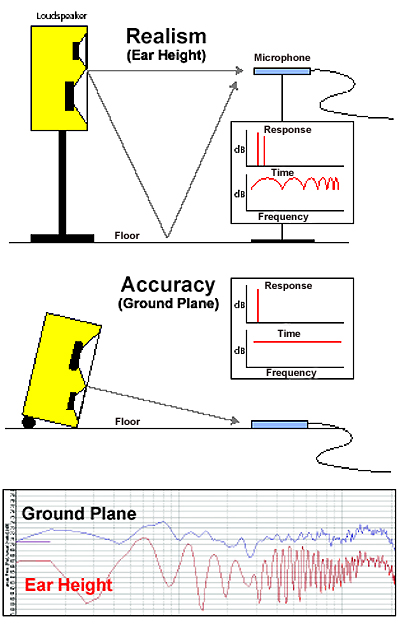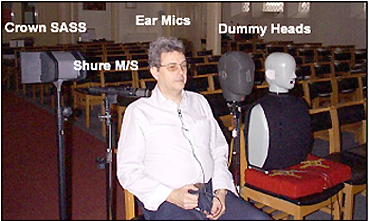
Is the goal of the measurement accuracy or realism? If the purpose of the measurement is to calibrate an equalizer or crossover network, then accuracy should be considered first.
It is desireable to know the true acoustic response of a transducer at a point in space, usually for the purpose of improving this response through signal processing.
In Figure 1 you wil see a stereo microphone on a stand at ear height might convey what a listener will hear, but this response will include seat-dependent artifacts, such as a strong reflection from the floor or other nearby objects.

The resultant comb filters will make it impossible to observe the response that is due to the loudspeaker alone.
If one were to attempt to compensate for the effect of the floor reflection, the compensation would not be correct for a closer or more distant listener seat. As such, it is best to ignore the floor reflection altogether when “tuning” the system.
Also, such a “seat dependent” response would average out if a large number of measurements were averaged across an auditorium.
This is why near-field and ground plane measurement techniques play an important role in sound system tuning. (This article is about neither – we’ll table this discussion for the future.)
Case For Realism
If the measurer wants to know what a sound system/room sounds like, then accuracy must give way to realism. Realism requires a binaural recording technique, and it must include the same effects from the room that might affect a live listener.
Mic placement is actually much easier than when considering accuracy, as the measurer simply listens to the system wherever he/she like and then replaces his/her head with the microphone. See Figure 2 for mic choices, which include:

Stereo.
A simple stereo mic can yield left/right information. Two cardioid mics in an X/Y configuration can yield convincing stereo.
Spaced omnidirectional mics are another popular method. This is art, not science so there really aren’t any rules to break. If you like what you hear, then it’s O.K.
Head Simulation. An added element of realism can be achieved by simulating the presence of a human head. The “head effect” is called the Head-Related-Transfer-Function (HRTF.) The Crown SASS uses omni mics spaced at human dimensions with an absorptive mass in between.
Frequency-dependent directivity is achieved by boundary-loading the mics on small, flat panels.
Head/Torso/Pinnae Simulation. Perhaps the best binaural mic is the dummy head. This includes the effect of the head, torso, and even the ear structure. The major benefits of this technique are customization and repeatability.
The response can be modified electronically and physically to whatever is desired, and setups can be recalled in the future if needed.
